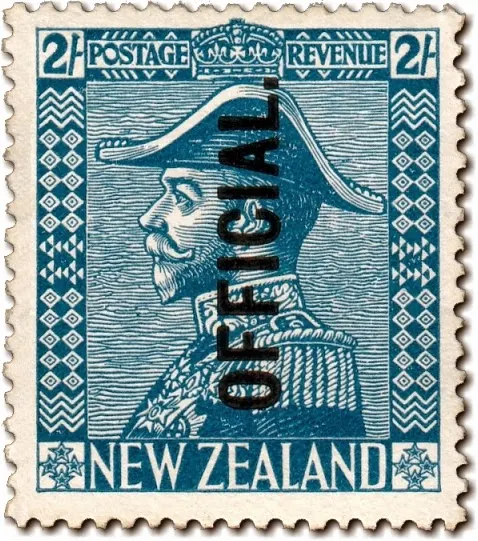King George V Admirals.
 By 1924 the demand for two and three shilling stamps was high enough that postal authorities considered it was worth producing new stamps rather than using 'Duty' stamps of those values. It was also decided to replace the one penny dominion with a new stamp as the plate needed replacing and the universal/dominion design had been in use for twenty-five years. Therefore these stamps must be considered as definitive stamps, usually seen by collectors as an addition to the 1915 King George V Definitives.
By 1924 the demand for two and three shilling stamps was high enough that postal authorities considered it was worth producing new stamps rather than using 'Duty' stamps of those values. It was also decided to replace the one penny dominion with a new stamp as the plate needed replacing and the universal/dominion design had been in use for twenty-five years. Therefore these stamps must be considered as definitive stamps, usually seen by collectors as an addition to the 1915 King George V Definitives.
The former Governor-General, Viscount Jellicoe, had been the commander of the British fleet at the Battle of Jutland in 1916, and so it was decided that the two and three shilling stamps would feature a portrait of King George V wearing the uniform of Admiral of the Fleet. General Sir Charles Fergusson, who had succeeded Viscount Jellicoe as Governor-General, was a distinguished soldier so the penny stamp was designed depicting King George V in the uniform of an Army Field Marshall.
I have never paid much attention to these three stamps, while they are included in my collection, I didn't know much about them. When I discovered the story behind these designs I realised what a clever idea it was. Here is an issue that pays tribute to both the previous and current Governor-Generals of New Zealand, and the current King George V.
1d - Field Marshall. 2/- Blue Admiral. 3/- Violet Admiral.
1d - Field Marshall. 2/- Blue Admiral.
The Design Close-up.
This stamp design is another fine example of engraving work. I can't help but admire the detail those men managed to get into their work. I think that might be one reason I have focused on classic stamps. In this case the work was done by H Linley Richardson, of Wellington and the printing was by Government Printing Office, New Zealand. Surface printing did not have the same sharp appearance as the more expensive recess printing. One of the problems of this form of printing was that when lines came close together, the gaps between could get filled-in as can be seen in areas of the background but I don't really think anyone could complain about the resulting image quality shown on this example above.
Examples of errors in the 'Official' overprint.
In the first pair the dot after the word 'OFFICIAL' is missing on the right-hand stamp. In the second pair the overprint has shifted too high up so now the word 'OFFICIAL' has almost run off the stamp, in fact the dot can be seen on the stamp above.
Postage and Revenue Uses.
1d Admiral Strip 4 used on Registered Cover, send from Taihape on 12th January, 1933. Its interesting how they used 4 1d stamps instead of a 4d King George V.
Covers with the 2/- or the 3/- are almost impossible to find since they would never have been used on a single letter. These value stamps were mainly used for parcels and attached to the wrapper which would get destroyed as the parcel was opened. I've had to resort to a 'stamp on piece' for this example, a 1926 2/- Blue Admiral. In 2014 this item was valued at Cat $75.00.
A 1d Admiral X 2 used on private cheque form Hautai Farm 1929, paid on the BNZ. Notice how, in both this example and the one below, the stamps have been dated and signed. This practice was used to help prevent tax avoidance by confirming that the stamps had been purchased as payment of tax.
On the 1929 Invoice letterhead from The Dimbula Tea Company Auckland, 1d Admirals pair used to pay stamp duty on the transaction completed. Again we can see the signed and dated stamps but in this case the company name has also been stamped across both postage stamps.
Some of the images in this post were used with permission from the illustrated catalogue of StampsNZ












I see the King no longer is wearing his lamp shade. Ha! Ha!
ReplyDeleteAndrew.
what is the price
ReplyDeleteWe are not stamp dealers so have little interest in prices. I suggest you follow the link above to StampsNZ who have prices for all NZ stamps on their website.
ReplyDeleteThanks,
Asami